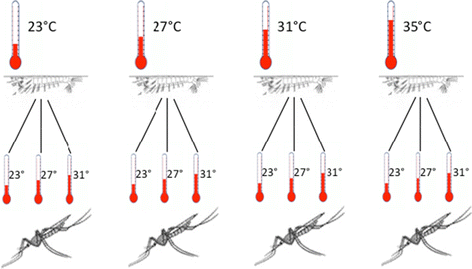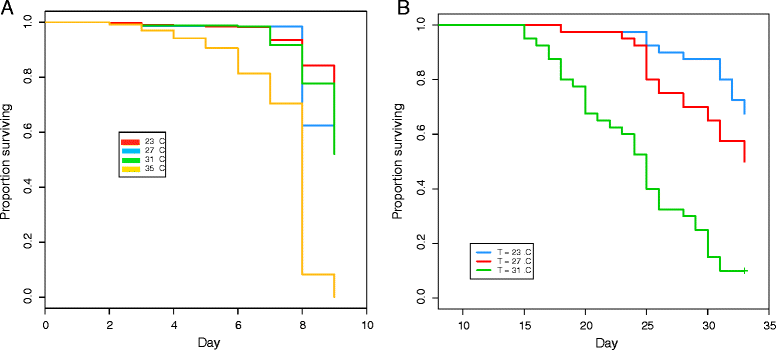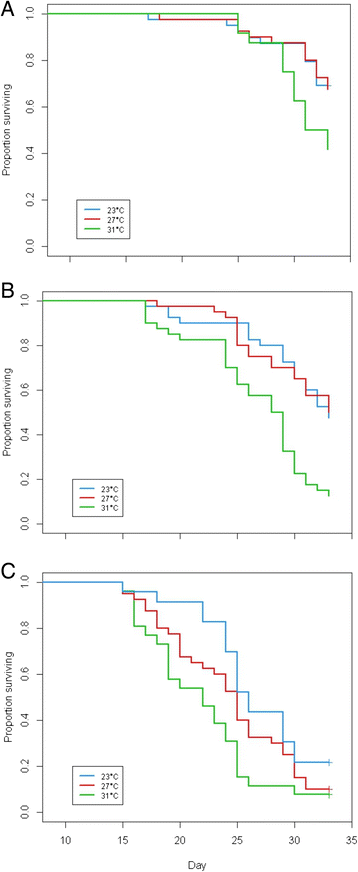Temperature during larval development and adult maintenance influences the survival of Anopheles gambiae s.s
- PMID: 25367091
- PMCID: PMC4236470
- DOI: 10.1186/s13071-014-0489-3
Temperature during larval development and adult maintenance influences the survival of Anopheles gambiae s.s
Abstract
Background: Malaria transmission depends on vector life-history parameters and population dynamics, and particularly on the survival of adult Anopheles mosquitoes. These dynamics are sensitive to climatic and environmental factors, and temperature is a particularly important driver. Data currently exist on the influence of constant and fluctuating adult environmental temperature on adult Anopheles gambiae s.s. survival and on the effect of larval environmental temperature on larval survival, but none on how larval temperature affects adult life-history parameters.
Methods: Mosquito larvae and pupae were reared individually at different temperatures (23 ± 1°C, 27 ± 1°C, 31 ± 1°C, and 35 ± 1°C), 75 ± 5% relative humidity. Upon emergence into imagoes, individual adult females were either left at their larval temperature or placed at a different temperature within the range above. Survival was monitored every 24 hours and data were analysed using non-parametric and parametric methods. The Gompertz distribution fitted the survivorship data better than the gamma, Weibull, and exponential distributions overall and was adopted to describe mosquito mortality rates.
Results: Increasing environmental temperature during the larval stages decreased larval survival (p < 0.001). Increases of 4°C (from 23°C to 27°C, 27°C to 31°C, and 31°C to 35°C), 8°C (27°C to 35°C) and 12°C (23°C to 35°C) statistically significantly increased larval mortality (p < 0.001). Higher environmental temperature during the adult stages significantly lowered adult survival overall (p < 0.001), with increases of 4°C and 8°C significantly influencing survival (p < 0.001). Increasing the larval environment temperature also significantly increased adult mortality overall (p < 0.001): a 4°C increase (23°C to 27°C) did not significantly affect adult survival (p > 0.05), but an 8°C increase did (p < 0.05). The effect of a 4°C increase in larval temperature from 27°C to 31°C depended on the adult environmental temperature. The data also suggest that differences between the temperatures of the larval and adult environments affects adult mosquito survival.
Conclusions: Environmental temperature affects Anopheles survival directly during the juvenile and adult stages, and indirectly, since temperature during larval development significantly influences adult survival. These results will help to parameterise more reliable mathematical models investigating the potential impact of temperature and global warming on malaria transmission.
Figures



Similar articles
-
Larval and adult environmental temperatures influence the adult reproductive traits of Anopheles gambiae s.s.Parasit Vectors. 2015 Sep 17;8:456. doi: 10.1186/s13071-015-1053-5. Parasit Vectors. 2015. PMID: 26382035 Free PMC article.
-
Temperature-related duration of aquatic stages of the Afrotropical malaria vector mosquito Anopheles gambiae in the laboratory.Med Vet Entomol. 2004 Jun;18(2):174-9. doi: 10.1111/j.0269-283X.2004.00495.x. Med Vet Entomol. 2004. PMID: 15189243
-
Larval habitats of Anopheles gambiae s.s. (Diptera: Culicidae) influences vector competence to Plasmodium falciparum parasites.Malar J. 2007 Apr 30;6:50. doi: 10.1186/1475-2875-6-50. Malar J. 2007. PMID: 17470293 Free PMC article.
-
The relationship between size and longevity of the malaria vector Anopheles gambiae (s.s.) depends on the larval environment.Parasit Vectors. 2018 Aug 29;11(1):485. doi: 10.1186/s13071-018-3058-3. Parasit Vectors. 2018. PMID: 30157916 Free PMC article.
-
Contributions of Anopheles larval control to malaria suppression in tropical Africa: review of achievements and potential.Med Vet Entomol. 2007 Mar;21(1):2-21. doi: 10.1111/j.1365-2915.2007.00674.x. Med Vet Entomol. 2007. PMID: 17373942 Review.
Cited by
-
Temperature-mediated dynamics: Unravelling the impact of temperature on cuticular hydrocarbon profiles, mating behaviour, and life history traits in three Drosophila species.Heliyon. 2024 Aug 22;10(17):e36671. doi: 10.1016/j.heliyon.2024.e36671. eCollection 2024 Sep 15. Heliyon. 2024. PMID: 39263086 Free PMC article.
-
Malaria transmission potential could be reduced with current and future climate change.Sci Rep. 2016 Jun 21;6:27771. doi: 10.1038/srep27771. Sci Rep. 2016. PMID: 27324146 Free PMC article.
-
Aggravation of Human Diseases and Climate Change Nexus.Int J Environ Res Public Health. 2019 Aug 6;16(15):2799. doi: 10.3390/ijerph16152799. Int J Environ Res Public Health. 2019. PMID: 31390751 Free PMC article. Review.
-
Stability of the effect of silencing fibronectin type III domain-protein 1 (FN3D1) gene on Anopheles arabiensis reared under different breeding site conditions.Parasit Vectors. 2020 Apr 19;13(1):202. doi: 10.1186/s13071-020-04078-2. Parasit Vectors. 2020. PMID: 32307003 Free PMC article.
-
Assessment of environmental and spatial factors influencing the establishment of Anopheles gambiae larval habitats in the malaria endemic province of Woleu-Ntem, northern Gabon.Malar J. 2024 May 21;23(1):158. doi: 10.1186/s12936-024-04980-5. Malar J. 2024. PMID: 38773512 Free PMC article.
References
Publication types
MeSH terms
LinkOut - more resources
Full Text Sources
Other Literature Sources

